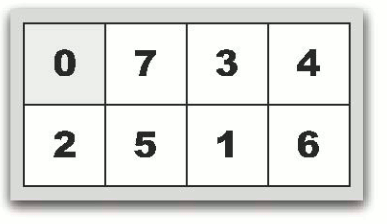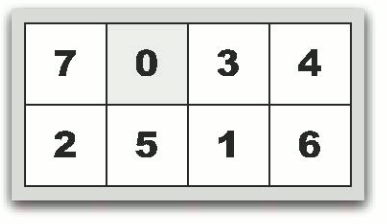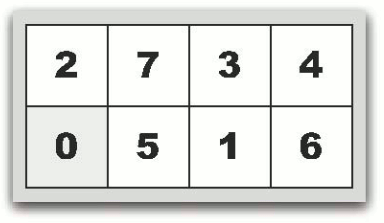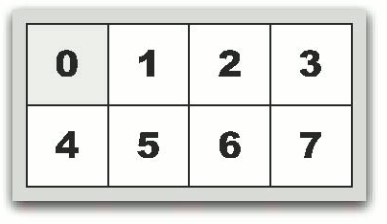
2.1 最基础的“穷竭搜索” 广度优先搜索
有一个4*2的方框,里面随机填充着0-7这8个数。每次只有0可以交换相邻格子里的数。比如:

可以交换为

也可以交换为

,最终希望8个数整齐地排列为

求最小的交换次数。
输入:
0 1 2 3 4 5 6 7 1 0 2 3 4 5 6 7 7 6 5 4 3 2 1 0
输出:
0 1 28
跑个题,这题的日文注解在下一页,如果你喜欢日语的话欢迎翻页看原题注解。
思路:与前几题的bfs不同,这次的bfs没有明确的移动对象,看似任意一个数都可以当成对象移动。把0作为移动对象,那么0在地图中漫游所有的格子得到的肯定就是问题的解空间。由于题目的输入是多个case,如果对每个case都运行一遍bfs就会TLE。这时我们祭出dp技能,只需要一次bfs就将解空间算出来,以后每个case只要到解空间中去找就行了。
#include <iostream>
#include <string>
#include <algorithm>
#include <map>
#include <queue>
using namespace std;
map<string, int> dp;
int direction[4] = { 1, -1, 4, -4 };
//************************************
// Method: bfs
// FullName: bfs
// Access: public
// Returns: void
// Qualifier: 让0漫游整个字串
//************************************
void bfs()
{
queue<string> que;
que.push("01234567");
dp["01234567"] = 0;
while (!que.empty())
{
string now = que.front(); que.pop();
// p是'0'的位置
int p = 0;
for (int j = 0; j < 8; ++j)
{
if (now[j] == '0')
{
p = j;
break;
}
}
for (int i = 0; i < 4; ++i)
{
int n = p + direction[i];
if (0 <= n && n < 8 &&
!(p == 3 && i == 0) && // 右上角不能再往右了
!(p == 4 && i == 1)) // 左下角不能再往左了
{
string next = now;
swap(next[p], next[n]);
if (dp.find(next) == dp.end())
{
dp[next] = dp[now] + 1;
que.push(next);
}
}
}
}
}
///////////////////////////SubMain//////////////////////////////////
int main(int argc, char *argv[])
{
bfs();
string line;
while (getline(cin, line))
{
line.erase(remove(line.begin(), line.end(), ' '), line.end());
cout << dp[line] << endl;
}
return 0;
}
///////////////////////////End Sub//////////////////////////////////
![]() 知识共享署名-非商业性使用-相同方式共享:码农场 » AOJ 0121: Seven Puzzle 《挑战程序设计竞赛(第2版)》练习题答案
知识共享署名-非商业性使用-相同方式共享:码农场 » AOJ 0121: Seven Puzzle 《挑战程序设计竞赛(第2版)》练习题答案
 码农场
码农场
并不是随便抓一个当作移动对象,比如02134567就还是0,而是0作为空格,是可交换移动的
作者你好,能不能解释下这句dp.find(next) == dp.end()是什么意思 我对STL的东西不怎么懂 谢谢!
dp.find(next) == dp.end()表示不存在 我还是不理解 能详细点吗 不胜感激
我懂了。很巧妙!学习 了!
谢谢作者的代码,我可以问一下
if (dp.find(next) == dp.end())
{
dp[next] = dp[now] + 1;
que.push(next);
}
这一段的意思是不是表示如果他是一个新找到的字符串(说明是最早找到的,所以在map里面是末尾),那我们就入队?
dp.find(next) == dp.end()表示不存在
line.erase(remove(line.begin(), line.end(), ‘ ‘), line.end());这个的有什么用
删空格